The Big Bang Theory creators Bill Prady and Chuck Lorre discuss the series — and the pilot you didn't see
Bazinga! The Big Bang Theory celebrates its 15th anniversary on Sept. 24.
Before Shamy, the Wil Wheaton rivalry, and Howard's (Simon Helberg) trip to space, there was a pilot episode that premiered on CBS in 2007. In the episode, two nerdy guys, Leonard (Johnny Galecki) and Sheldon (Jim Parsons), discover that a hot blonde has moved in across the hall. The concept was simple. The result was anything but.
Big Bang's cast of misfit characters felt incredibly relatable for many and, before long, their friendship and misadventures had captivated America. By the time The Big Bang Theory ended in 2019, it had aired 279 episodes and had won numerous awards, including four Outstanding Lead Actor Emmys for star Jim Parsons.
Now, 15 years after the pilot's premiere, the show's creators, Bill Prady and Chuck Lorre, look back at the series' legacy, their favorite moments, and their thoughts on a reunion.
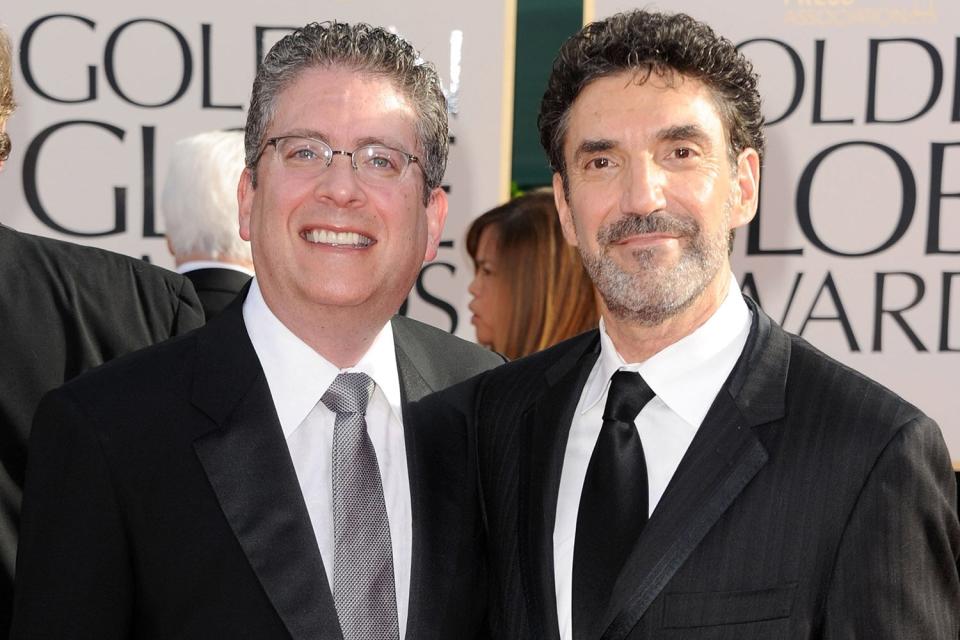
Frazer Harrison/Getty Bill Prady and Chuck Lorre
ENTERTAINMENT WEEKLY: This September marks 15 years since The Big Bang Theory premiered. So, I want to know all about the pilot. How did all of this come together? How did you create that first episode?
BILL PRADY: Well, that pilot was actually the second pilot we had done after the first one didn't work for a bunch of reasons. In the first pilot, the female character (who, at that point, was named Katie) is kind of rough. She's dangerous in a way and wasn't very nice to the guys. I remember going to the test screening, the dial testing...
CHUCK LORRE: Yeah, the audience hated her.
PRADY: They hated her, but what was amazing was that they were defending Leonard and Sheldon so much.
LORRE: Yeah, we didn't realize early on that the audience viewed them as children. They were very naive and childlike, regardless of how intelligent they were. They were very vulnerable, and the audience didn't want a toxic presence around them. That's why we rewrote Katie to become Penny [Kaley Cuoco] and made her much more charmed by the guys and kind to them, as opposed to a woman who would take advantage of them.
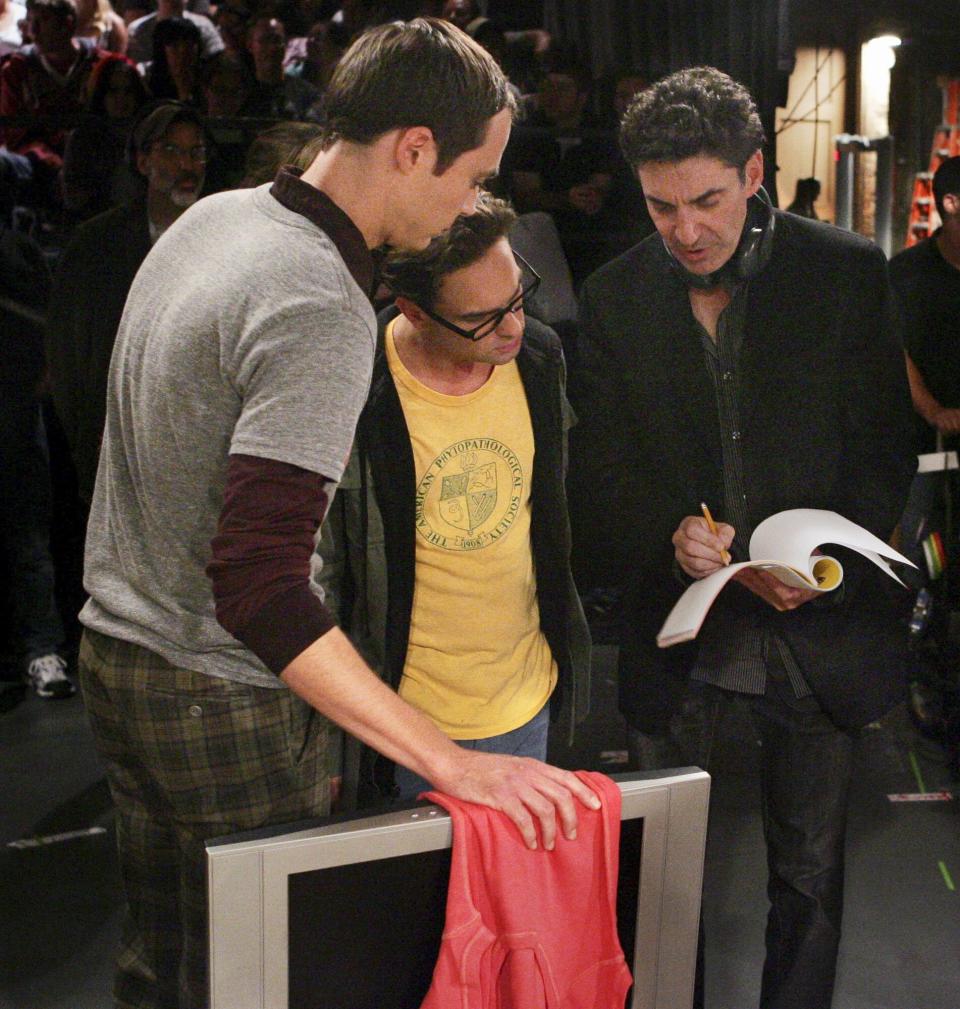
WarnerMedia Jim Parsons, Johnny Galecki, and Chuck Lorre
Who played the original Penny?
PRADY: The actress was Amanda Walsh, and she did a great job playing that character.
LORRE: She was terrific in the role, but the role was misconceived. It was our responsibility.
PRADY: Yeah, she was actually a very sweet person, and it was a lot of work for her to become that rough character. Afterward, she wanted to come back in for the new version of Penny, but she had been so identified as that first character that it wasn't able to happen.
LORRE: The miracle of this show is that we got an opportunity to learn from our mistakes and make it better. CBS called after the first pilot and asked if we could do it again and recast the female lead... but my response to them was, "No, I don't think it was a casting problem, I think it was a writing problem." Our script didn't fully realize what our possibilities were. I told Bill, "Let's add more of these brilliant misbegotten characters, and let's lose the plot entirely. Let's just spend a half hour diving into the lives of these brilliant misfit characters."
When you think about it, the plot of the second pilot is pretty simple. Leonard meets an incredible woman, he's obsessed with her, she's the woman of his dreams, and he wants to win her heart. So, she gives him a task, he fails at it, and then they all eat dinner! [Laughs]
PRADY: I disagree and say there's a real plot in that pilot and there's a real big question that's asked. Leonard says, "Should we invite her to lunch?" And Sheldon responds with, "To what end?" To me, Leonard's struggle was always that Penny was like the outside world. She was like, come out dancing, come out and see things. And Sheldon, on the other hand, was like, come back in here, we have DVD commentaries to watch and we have Dungeons and Dragons to play.

WarnerMedia Behind the scenes of 'The Big Bang Theory'
LORRE: Penny was a risk.
PRADY: Exactly. Personally, I think the world is a terrifying place, and I hate parties and talking to people and all that, so I get that idea of, "Maybe I should just stay home and watch Star Trek... Star Trek is my friend, and Star Trek has never failed me."
LORRE: Sheldon had a very circumscribed life. But Penny was this random element that was introduced into their lives and changed them forever. Sheldon was never able to have the rigid order he wanted after her arrival.
Speaking of the characters, how did the idea of making Raj (Kunal Nayyar) not able to talk around women come about?
LORRE: Bill worked with a guy in the 1980s, a computer programmer, that was actually like that.
PRADY: Yes, and that attribute actually belonged to the fellow who had most of Sheldon's attributes as well. Somehow, in our discussions, that moved out of the Sheldon character and into Raj.
LORRE: Yeah, we created two characters out of that one guy.
PRADY: It was a really interesting thing to watch because if we were talking and a woman came into the room, he would just stop talking. And then she would leave, and he would start talking again. Obviously, we started noticing it. It's a real thing, selective mutism. It's an anxiety condition. He was just so anxious around women that his solution was to not talk.
LORRE: And Penny is the one who cured Raj. She was the pivot point for all these characters. She was also the one who told Howard, "You're not a ladies' man… you're disgusting." But she also introduced him to Bernadette. She impacted all these characters in such a major way.
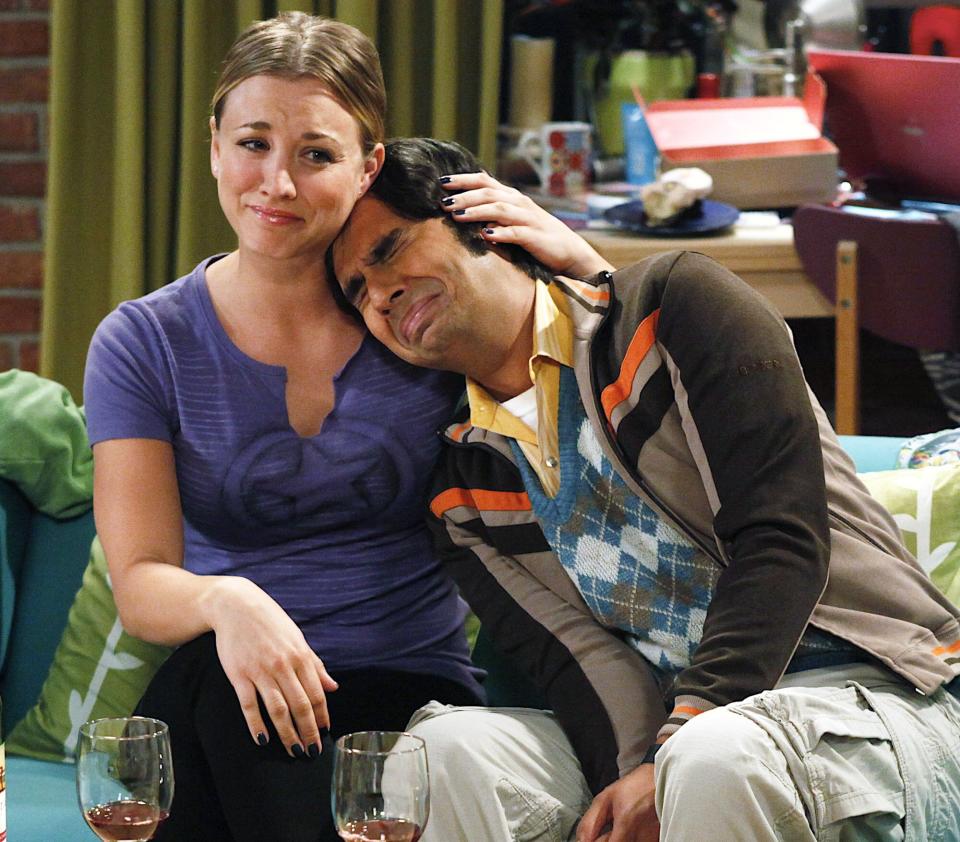
WarnerMedia Kaley Cuoco and Kunal Nayyar on 'The Big Bang Theory'
Being different seems to be an ongoing plot device for almost every character in the show. Everyone's got their "thing," but the show never seems to be preachy about it or use it as a malicious joke. Was that at the forefront of your mind when creating the series?
LORRE: These characters were struggling to participate in the world and it was hard and even painful to do so. That's something we've all felt and can understand. I think most people can identify with it on some level, that alienation, even popular people.
PRADY: Chuck used to talk about the difference between A Beautiful Mind and Revenge of the Nerds. To me, as someone who worked on computers and was in that world, the depiction media gives of the "nerd" world is very homogenous. But to me, it was the most interesting place. People had interests in random things like Tuvan throat singing and they'd want to tell you all about them.
LORRE: That's you, Bill! [Laughs]
What's a scene or episode that's always stuck out as your favorite part of the whole series?
LORRE: Jim Parsons' speech about why he sits in that particular spot on the couch in the pilot episode. I think we all watched that and understood something remarkable was happening. There were no real jokes in the speech, it was just a worldview that was so precise, and he brought it to life. It was an astounding moment I'll never forget.
PRADY: I love the episode where Sheldon doesn't like that Leonard is dating Raj's sister. She was a lawyer and kept finding loopholes in the roommate agreement and was using it against him. Sheldon gets so mad that he ends up threatening to tell her parents she was dating Leonard and uses the Star Trek self-destruct sequence to do it. To me, that was this great nerd explosion. Then there's the incredible moment with the Christmas gift where Penny gives Sheldon a napkin with Leonard Nimoy's DNA on it.
LORRE: That's when he hugged Penny. It was the first time he laid a hand on her. That was a big character breakthrough moment, he was so alienated up to that point.
Another person who really helped Sheldon was Amy (Mayim Bialik), who also went through a big progression from her first appearance. How did that evolution happen?
LORRE: Again… it's Penny. Because, originally, Amy's first love was Penny. She wanted girlfriends and a social life with other women because she was denied that as a child. That was the first breakthrough with her character. It wasn't with Sheldon, it was with the girls.
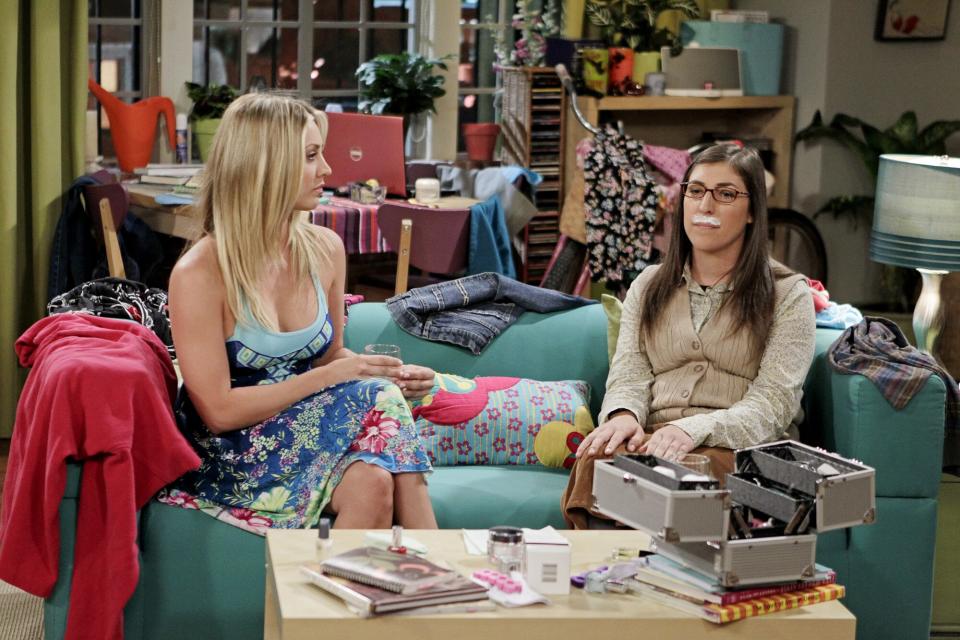
WarnerMedia Kaley Cuoco and Mayim Bialik on 'The Big Bang Theory'
PRADY: She got to go through the kind of adolescence she wished she could have gone through as a kid. She got to experience sleepovers and shopping and all those things her mother hadn't let her do. So that's part of the evolution, but she also pulled Sheldon along. He was faced with the question of: Either I have to do things this person wants or not have this person in my life. It was the first time he really confronts the idea of having to change, because he doesn't want to lose this person from his life.
LORRE: We thrust unconditional love at him and he finally melted. It took about five years, but he did eventually melt!
The era Big Bang started in vs. the era it ended in vs. now are all so different. Do you think the world has gone through such a massive change that a reboot or reunion should happen, or do you think it's too soon?
PRADY: So much has happened. We've lived through so many things. If you were able to go check in on the characters, if you were able to drive to Pasadena and find them, they would all have lots of opinions about the things that are happening.
LORRE: Sheldon would have loved the pandemic. Being able to stay at home and not deal with the world? He would have thought it was perfect.
PRADY: And he would have loved it because people would have had to listen to him because he's a person who knows about germs… and all of the sudden, the focus of the entire world is on people who know things like that. But, also, Bernadette [Melissa Rauch] is a microbiologist and works with people who probably know things, so I can imagine she and Sheldon would probably argue about that. I can already hear her scream, "Don't tell me about my job!"
LORRE: We would have done two seasons with Sheldon in a hazmat suit.
PRADY: Absolutely! Like the John Travolta Boy in the Bubble movie! [Laughs]
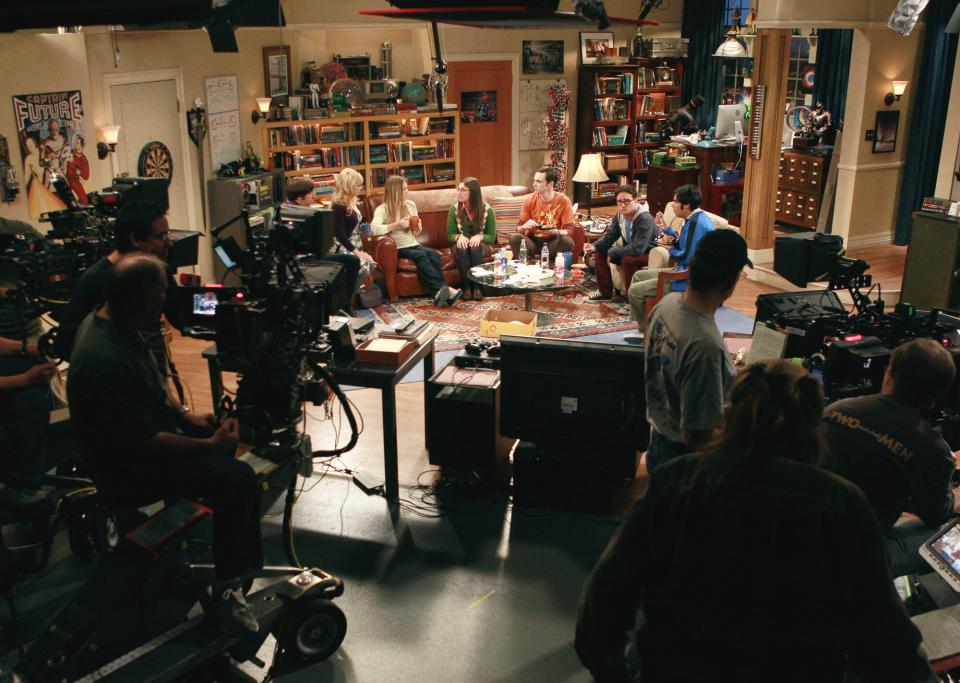
WarnerMedia Shooting 'The Big Bang Theory'
PRADY: I know that people do get characters together for reunions and things like that, but it's hard to imagine what you would see after the finale because I found the finale was one of the most beautiful and satisfying episodes. The closure it brought was astonishing. It's hard to imagine reopening the story after that.
LORRE: I agree, I don't think we left anything undone. That was as close to a perfect finale as we could have ever dreamt of doing. I loved it.
PRADY: The story for that finale really starts about four episodes before. The last four or five episodes are actually just one giant story. But would I like to stand on a stage someplace and watch those characters again? Yes, absolutely. Can I imagine a way to do it? I can't. But, personally, would l like to go to Stage 25 and see that set and those costumes and those people? Yeah, I get choked up just thinking about it. But I don't know how we'd do that.
Alright, final question. I want to know a behind-the-scenes story that you've never told anyone before.
PRADY: I have a great one. So on the set we had tons of antique scientific equipment. People always ask what that thing on the wall post was. It was this wooden box, which was actually an antique Geiger counter. Throughout the show's run, really famous scientists visited the set all the time. We had Nobel laureates and astronauts, we even had tech guys and corporate titans like Bill Gates and Steve Wozniak.
LORRE: Steve actually came back and visited like five more times after he filmed his episode. He'd come by and just hang out.
PRADY: So, one day this super famous physicist was visiting. We're doing the set tour we always gave after taping because everyone wants to get their picture taken in Sheldon's spot, and the physicist looks at the wooden box and goes, "That's an old Geiger counter." We say, "Yes, that is." Then he says, "You know, those old Geiger counters often had a piece of uranium in them to use for calibration, before people realized that's a stupid idea."
He said, "I wonder if there's uranium in that." Then he goes, "Hang on, I've got a working Geiger counter in the trunk of my car." He went out and grabbed it and brought it over to the set and, of course, the thing starts going off and making noises. So he opened up the old Geiger counter, saw the uranium, and said, "I'm going to put this in a lead box and take it away now." And then he removed a piece of uranium from the Geiger counter and left! [Laughs]
LORRE: Yeah, that's kinda like a class-action suit waiting to happen. We had uranium on the set of The Big Bang Theory.
PRADY: Should we not print that? [Laughs]
LORRE: [Laughs] I don't know, Bill! I can see some law firm with a commercial on CNN saying, "Were you or a loved one ever on the set of The Big Bang Theory?" That's great Bill, thanks for sharing that. Well, what are you gonna do…
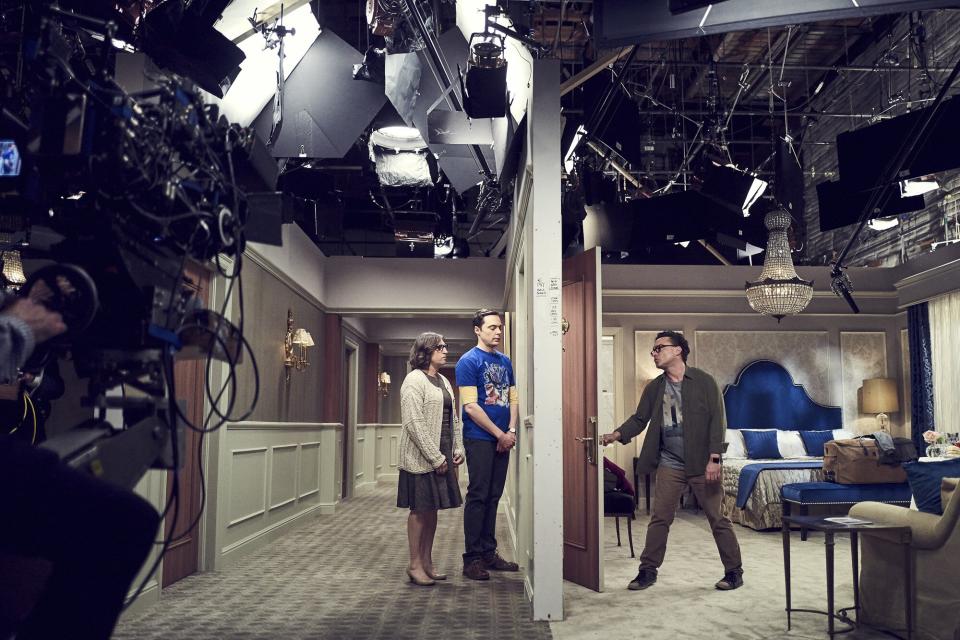
WarnerMedia Shooting 'The Big Bang Theory'
PRADY: Well, do you have a better story, Chuck?
LORRE: I remember that after our first season we went to Comic-Con and I thought it was a horrible idea. The publicist said we were going to do a panel and I remember telling the cast to not get their hearts broken when only 11 people show up. I said, "Let's just go have a good time, we'll have fun and then have a nice dinner, let's not make a big deal of it."
Turns out, there were 4,000 people who came, It was standing room only. People camped in tents the night before. There was an autograph signing afterward and I was sitting there next to Jim and people were coming up to him and they were crying. They were crying tears of joy to be getting an autograph from Jim Parsons. The characters meant so much to them that it was like getting autographs from The Beatles. They were starstruck. That was the moment when I was like, something remarkable is happening that's way beyond anything I'd ever seen.
PRADY: Yeah, the difference between the first and second year was incredible. We had this amazing crowd the first year, but the guys were still able to exist out in the world. We even walked the Comic-Con floor that first year. The cast would get looks, but they were still able to blend in. I remember because Johnny wanted to walk around and see the G.I. Joe stuff.
That autograph signing you're talking about was actually the second year. We were put in a bigger hall that year and the cast literally couldn't be outside or they would have been mobbed. They couldn't move without security. I remember thinking, "A year ago, we walked on the floor looking for G.I. Joe, and now this."
LORRE: There was a very personal connection between fans and the cast. They meant something. They had significance in people's lives, it was remarkable. It will always be remarkable. We connected with a lot of people who felt alienated, the same way these characters did. They wanted to be a part of life, but they didn't know how. And these characters said, here's how — you create your own community and your own family. They showed the world that nobody has to be alone.
Related content:

 Yahoo Sport
Yahoo Sport 





































